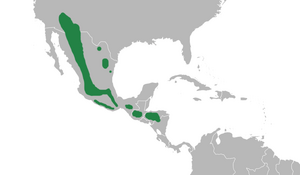Olive warbler facts for kids
Quick facts for kids Olive warbler |
|
|---|---|
 |
|
| Conservation status | |
| Scientific classification | |
 |
The olive warbler (Peucedramus taeniatus) is a small passerine bird. It's the only member of its group, called Peucedramus, and its own special family, Peucedramidae.
This bird lives in North and Central America. You can find it from southern Arizona and New Mexico in the USA, all the way south through Mexico to Nicaragua. It's the only bird family that is found only in North America.
Scientists used to think it was part of the New World warbler family. But DNA studies showed it's very different. It split off from other related birds a long time ago. That's why it now has its very own family!
Olive warblers eat insects and live in coniferous forests. These are forests with trees like pines and firs. Most olive warblers in New Mexico leave during the winter. They usually lay 3 to 4 eggs in a nest built in a tree.
Contents
A Unique Bird Family
The olive warbler is special because it has its own family. Scientists first thought it was a New World warbler. It looked similar and had nine main flight feathers like them.
But over time, studies showed it was different. Its skull shape and how it acted were not like New World warblers. Also, the muscles in its legs were different.
Later, DNA studies proved it was unique. These studies looked at the bird's genetic material. They showed the olive warbler split off very early from other bird groups. This is why it now has its own family, Peucedramidae.
What's in a Name?
The scientific name for the olive warbler is Peucedramus taeniatus.
- Peucedramus comes from ancient Greek words. Peuke means "fir tree," and dromos means "runner." This describes how the bird moves in fir trees.
- Taeniatus comes from the Latin word taenia, meaning "headband." This refers to the black stripe that looks like a mask across its eyes.
The bird was first called olivaceus. But that name was already used for another animal. So, its name was changed to taeniatus.
What the Olive Warbler Looks Like
The olive warbler is a medium-sized bird. It is about 13 to 14 cm (5 to 5.5 in) long. It weighs about 9.5 to 12 g (0.3 to 0.4 oz).
Birds living further north are usually a bit bigger. This is a common pattern in nature.
Feathers and Colors
The male olive warbler has mostly grey feathers on its body. Its wings have some olive-green color and two white stripes.
- The male's head and chest are a "tawny-orange" color.
- It has a clear black patch that goes through its eye, like a mask.
Female and young olive warblers look a bit different.
- Their orange colors are replaced by yellow.
- Their black eye mask is not as strong or clear.
Birds living in southern areas often have brighter colors than those in the north.
Their Song
The olive warbler's song is made of clear whistles. It sounds like hirrJI hirrJI hirrJI or plida plida plida chir chir.
Male olive warblers sing all year long. They sing more often in late winter and early spring. During spring, they sing almost constantly in the mornings and late afternoons. They usually sing from the tops of tall trees.
Where They Live and Their Home
The olive warbler lives from the southwestern United States down to Nicaragua. It is the only bird family found only in North America.
In the USA, it lives in parts of Arizona and New Mexico. It then spreads through central Mexico. There are also separate groups of them in other parts of Mexico. You can also find them in southwest Guatemala, El Salvador, Honduras, and northern Nicaragua.
Mountain Homes
Olive warblers are mountain birds. They live in high places.
- In the northern parts of their range, they live at 2,600 m (8,500 ft) above sea level or higher. Some even live at 3,500 m (11,500 ft).
- Further south, like in Guatemala, they can be found as low as 1,850 m (6,000 ft).
- In Honduras and Nicaragua, they might live as low as 1,000 m (3,300 ft).
They mostly live in conifer forests. These include pine and fir forests. They can live in both humid and dry forests. Sometimes, they even use palm tree areas near the coast.
Do They Migrate?
Most olive warblers stay in the same area all year. They are called resident birds.
However, some birds in the northern parts of their range do move. They are called partial migrants. It's not fully clear where they go. Some might move to lower elevations in the mountains. Others might just spread out to new areas. Some have even been seen in Texas. But many birds still stay in the northern areas all year.
What They Eat and How They Find Food
The olive warbler is an insectivore. This means it eats insects and other small creatures like spiders.
Scientists don't know exactly which insects they eat most often. But they do eat the larvae (young) of certain moths.
Olive warblers look for food in forests. They usually search in the top parts of trees, called the canopy, and just below it. They mostly feed on the outer branches and twigs of trees. They especially like to find food in ponderosa pine trees. They also feed in oak trees.
See also
 In Spanish: Ocotero para niños
In Spanish: Ocotero para niños



